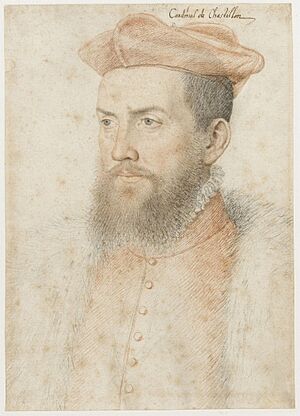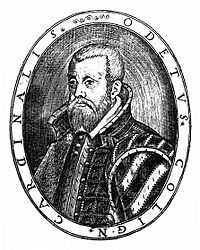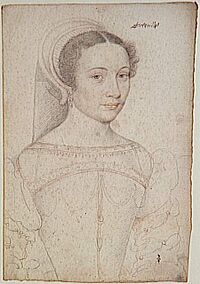Odet de Coligny facts for kids
Quick facts for kids Cardinal Odet de Coligny |
|
|---|---|
| Cardinal-Deacon | |
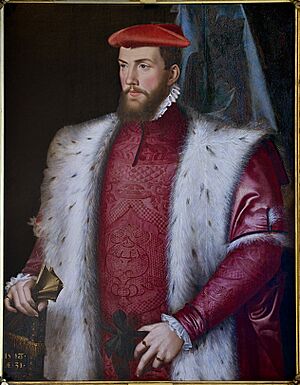
Portrait attributed to François Clouet, c. 1548
|
|
| Church | Ss. Sergio e Bacco Sant'Adriano al Foro |
| Diocese | Archbishop of Toulouse (1534-1550) Administrator of Beauvais (1535-1563) |
| Orders | |
| Ordination | never ordained Priest |
| Consecration | never consecrated Bishop |
| Created Cardinal | 7 November 1533 Cardinal de Châtillon |
| Personal details | |
| Born | 10 July 1517 Châtillon-Coligny, France |
| Died | March 21, 1571 (aged 53) Canterbury, England |
| Buried | Canterbury Cathedral |
| Nationality | French |
| Parents | Gaspard I de Coligny Louise de Montmorency |
| Signature | |
Odet de Coligny (born July 10, 1517 – died March 21, 1571) was an important French nobleman. He became a cardinal in the Catholic Church at a young age. He was also the Bishop-elect of Beauvais and a member of the French Royal Council. From 1534, people often called him the Cardinal of Châtillon.
Contents
Early Life and Family
Odet was born in Châtillon-Coligny, France, on July 10, 1517. He was the second son of Gaspard I de Coligny and Louise de Montmorency. His mother kept a special book where she recorded his birth.
Odet had three brothers: Pierre, Gaspard, and François. All the brothers were taught at home. Their teacher was Nicolas Bérauld of Orleans, who was a friend of a famous scholar named Erasmus.
Catholic Church Career
Odet held many important positions in the Catholic Church early in his life. In 1530, he became the prior of Saint-Étienne in Beaume. The King of France also chose him to be the Abbot of St. Euvertius in Orleans in 1531.
Becoming a Cardinal
On November 7, 1533, when Odet was only 16 years old, he was made a cardinal by Pope Clement VII. He received his cardinal's red hat and was given a special church in Rome called Santi Sergio e Bacco. Soon after, he became the Abbot of the royal abbey of Nôtre-Dame de Vauluisant.
In 1534, King Francis I of France chose Cardinal de Coligny to be the Archbishop of Toulouse. The Pope approved this, even though Odet had never been ordained as a priest. He was only sixteen, which was much younger than the usual age for an archbishop. The Pope gave him special permission to take the role.
Archbishop and Bishop Roles
Odet de Coligny served as the Administrator of the diocese of Toulouse until 1550. He was never officially made a bishop there. In 1534, at just 17, he took part in a meeting to choose a new Pope, where Pope Paul III was elected.
A year later, in 1535, he was chosen to lead the See of Beauvais. He managed the Beauvais diocese until 1563. During this time, other bishops helped with the spiritual duties because Odet was not consecrated as a bishop.
In 1545, Cardinal de Châtillon attended an important church meeting called the Ecumenical Council of Trent. When King Francis I died in 1547, Cardinal Odet and his brother François were close to the new King, Henri II. As a French nobleman, Odet attended the King's funeral and coronation.
Life Under King Henri II
Cardinal de Châtillon also participated in the meeting to elect a new Pope in 1549-1550. He arrived late, but his letters show how much politics were involved in choosing the Pope. After the new Pope, Pope Julius III, was elected, Odet quickly got approval for his role as Abbot of Fontainejean.
In 1550, Cardinal Odet de Châtillon was appointed Abbot of Saint Jean de Sens. He also became the Abbot of the royal Abbey of Fleury. He held these positions until 1563.
Supporting Writers
As a member of the King's Council, Odet was in charge of the Royal Privy Council's library. He used his position to protect his friends, the famous writers Ronsard and Rabelais. He worked with another cardinal, Jean du Bellay, who was Rabelais' first supporter.
In 1552, Odet helped Rabelais get a special ten-year right to print books. In thanks, Rabelais dedicated his book Quart Livre to Odet.
In 1553, Odet became the Abbot of Saint Bénigne de Dijon. In 1554, he ordered the publication of new rules for the Beauvais diocese. These rules included instructions for the clergy, like keeping their beards shaved and hair short. However, Odet himself wore a full beard, which was becoming fashionable.
In 1556, King Henri II appointed him Abbot of Ferrières Abbey. Four years later, the Pope named him the chief inquisitor of France. But the French Parliament did not allow him to take this job.
Meeting at Poissy
Cardinal de Châtillon took part in an important discussion called the Colloquy of Poissy in 1561. This meeting tried to find common ground between Catholics and Protestants. When the Protestant leader Theodore de Beze arrived, Odet and other nobles welcomed him with great honor.
Becoming a Protestant
In 1558, Odet's brother, François d'Andelot, was arrested for attending a Protestant meeting. People suspected Cardinal de Châtillon also held Protestant beliefs.
Under his family's influence, Odet eventually became a Protestant himself in April 1561. He joined the Calvinist Huguenot movement. He was not the only French church leader to become a Calvinist during this time.
On Easter Monday in 1562, Odet led a church service in the Episcopal Palace at Beauvais. This was unusual because he had never been ordained as a priest. Also, he used a service similar to the Calvinist style. This caused riots in Beauvais.
The Queen-mother, Catherine de' Medici, wanted Odet to help keep peace between Catholics and Protestants. She hoped he could help save the monarchy for her children. Even after he changed his religion, she wrote friendly letters asking for his help.
However, the Pope could not ignore a cardinal changing his religion. On May 21, 1562, Odet was ordered to appear before the Roman Inquisition. When he did not show up, he was officially removed from his church positions on March 31, 1563. The French government tried to stop this, but it failed.
Odet then gathered supporters and helped the Huguenot party. He took part in the religious wars with his brother. He also tried to mediate between Protestants and Queen Catherine de' Medici.
In 1562, he escaped to Lyon. He gave up his cardinal title and called himself the Count of Beauvais. The Pope and the French parliament officially removed him from all his offices because he was considered a heretic.
Marriage and Exile
In December 1564, Odet married his partner, Ysabel de Hauteville. A Huguenot minister performed the ceremony. Odet even appeared with his wife, wearing his cardinal's robes, at a ceremony for King Charles IX.
He fought in the Battle of Saint-Denis in 1567. In 1568, he fled to England. He wrote to King Charles IX and Queen Elizabeth, asking for safety in England.
In London, he asked Queen Elizabeth for money to help the French Protestants. Queen Elizabeth liked him and his wife. He lived in Shene and often wrote to Sir William Cecil, the Secretary of State, to help Protestants.
In 1569, Cardinal de Châtillon was asked by the Queen of Navarre and other Protestant leaders to get help from the Queen of England for the Third War of Religion.
In 1569, the Parliament of Paris took away all of Odet's honors, offices, and lands. His brother François also died that year.
Death
On October 9, 1570, Odet left England to go back to France. He planned to sail to La Rochelle to join his brother. But bad weather kept him from leaving. He decided to change his plans and go to Picardy instead, but his wife became very ill.
He returned to London and discussed a possible marriage between a French duke and Queen Elizabeth. On January 25, 1571, he left London again, not feeling well. His health got worse, and he suffered from "fits."
On March 21, 1571, Cardinal Odet de Coligny lost the ability to speak and died shortly after. He died in Canterbury, England, under mysterious circumstances. Some people thought he might have been poisoned by his servant, possibly on orders from the French government.
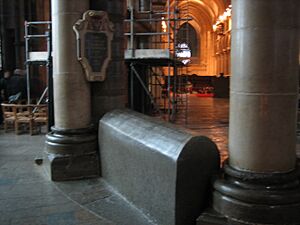
Queen Elizabeth ordered an investigation into his death. Odet's wife believed he had been slowly poisoned. However, his doctors did not agree with this idea. The investigation could not find any proof of poisoning.
Odet was buried in a simple, temporary tomb in the Trinity Chapel at Canterbury Cathedral. The plan was to move his body back to France later, but it never happened. He still rests there today.
Family Tree
|
||||||||||||||||||||||||||||||||||||||||||||||||||||||||||||||||||||||||||||||||||||||||||||||||||||||||||||||||||||||||||||||||||||||||||||||||||||||||||||||||||||||||||||||||||||||||||||||||||||||||||||||||||||||||||||||||||||||||||||||||||||||||||||||||||||||||||||||||||||||||
| Notes: | ||||||||||||||||||||||||||||||||||||||||||||||||||||||||||||||||||||||||||||||||||||||||||||||||||||||||||||||||||||||||||||||||||||||||||||||||||||||||||||||||||||||||||||||||||||||||||||||||||||||||||||||||||||||||||||||||||||||||||||||||||||||||||||||||||||||||||||||||||||||||
See also
 In Spanish: Odet de Coligny para niños
In Spanish: Odet de Coligny para niños


